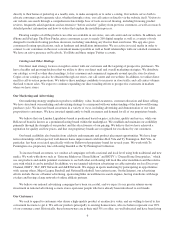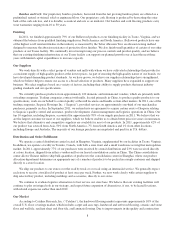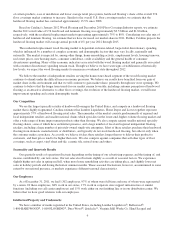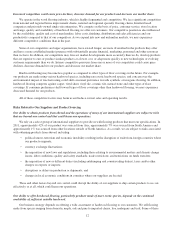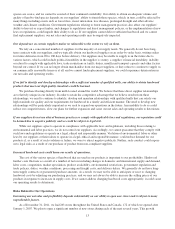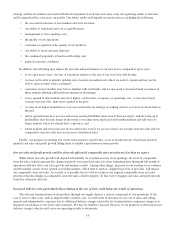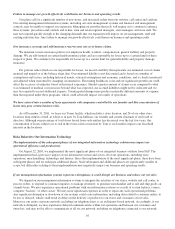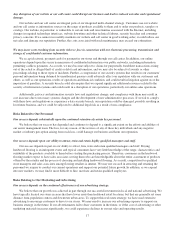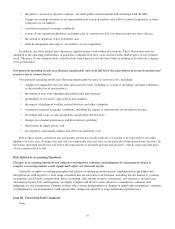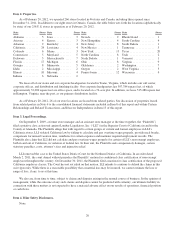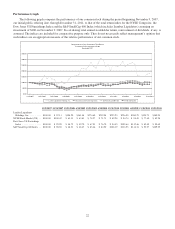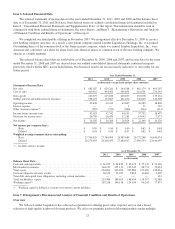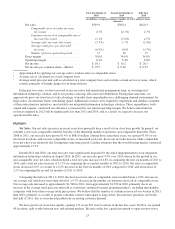Lumber Liquidators 2011 Annual Report Download - page 22
Download and view the complete annual report
Please find page 22 of the 2011 Lumber Liquidators annual report below. You can navigate through the pages in the report by either clicking on the pages listed below, or by using the keyword search tool below to find specific information within the annual report.Failure to manage our growth effectively could harm our business and operating results.
Our plans call for a significant number of new stores, and increased orders from our website, call center and catalogs.
Our existing management information systems, including our store management systems and financial and management
controls, may be unable to support our expansion. Managing our growth effectively will require us to continue to enhance
these systems, procedures and controls and to hire, train and retain regional managers, store managers and store staff. We
may not respond quickly enough to the changing demands that our expansion will impose on our management, staff and
existing infrastructure. Any failure to manage our growth effectively could harm our business and operating results.
Our insurance coverage and self-insurance reserves may not cover future claims.
We maintain various insurance policies for employee health, workers’ compensation, general liability and property
damage. We are self-insured on certain health insurance plans and are responsible for losses up to a certain limit for these
respective plans. We continue to be responsible for losses up to a certain limit for general liability and property damage
insurance.
For policies under which we are responsible for losses, we record a liability that represents our estimated cost of claims
incurred and unpaid as of the balance sheet date. Our estimated liability is not discounted and is based on a number of
assumptions and factors, including historical trends, actuarial assumptions and economic conditions, and is closely monitored
and adjusted when warranted by changing circumstances. Fluctuating healthcare costs and our significant growth rate could
affect the accuracy of estimates based on historical experience. Should a greater amount of claims occur compared to what
was estimated or medical costs increase beyond what was expected, our accrued liabilities might not be sufficient and we
may be required to record additional expense. Unanticipated changes may produce materially different amounts of expense
than that reported under these programs, which could adversely impact our results of operations.
We have entered into a number of lease agreements with companies controlled by our founder and this concentration of
leases may pose certain business risks.
As of December 31, 2011, we lease our Toano facility, which includes a store location, and 24 of our other store
locations from entities owned, in whole or in part, by Tom Sullivan, our founder and current chairman of our board of
directors. Although our percentage of total stores leased from such entities has decreased over the last few years, this
concentration of leases subjects us to risk in the event action or inaction by Tom or such entities impacts our leasehold
interests in the locations.
Risks Related to Our Information Technology
The implementation of the subsequent phases of our integrated information technology solution may impact our
operational efficiency and productivity.
On August 22, 2010, we implemented the most significant phase of our integrated business solution from SAP. The
implementation had a pervasive impact on our information system and across all of our operations, including store
operations, merchandising, technology and finance. Since that implementation of the most significant phase, there have been
subsequent phases and we anticipate additional phases. Such subsequent and additional phases are significantly smaller in
scope, but difficulties relating to their implementation may negatively impact our business and operating results.
If our management information systems experience disruptions, it could disrupt our business and reduce our net sales.
We depend on our management information systems to integrate the activities of our stores, website and call center, to
process orders, to respond to customer inquiries, to manage inventory, to purchase merchandise and to sell and ship goods on
a timely basis. We may experience operational problems with our information systems as a result of system failures, viruses,
computer “hackers” or other causes. We may incur significant expenses in order to repair any such operational problems.
Any significant disruption or slowdown of our systems could cause information, including data related to customer orders, to
be lost or delayed, which could result in delays in the delivery of products to our stores and customers or lost sales.
Moreover, our entire corporate network, including our telephone lines, is on an Internet-based network. Accordingly, if our
network is disrupted, we may experience delayed communications within our operations and between our customers and
ourselves, and may not be able to communicate at all via our network, including via telephones connected to our network.
16


